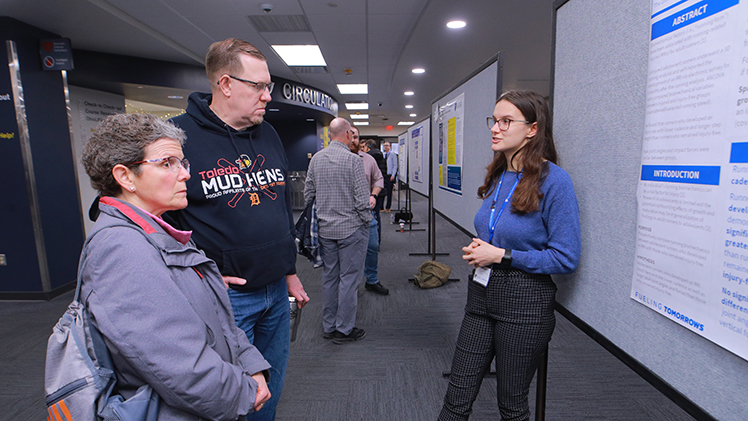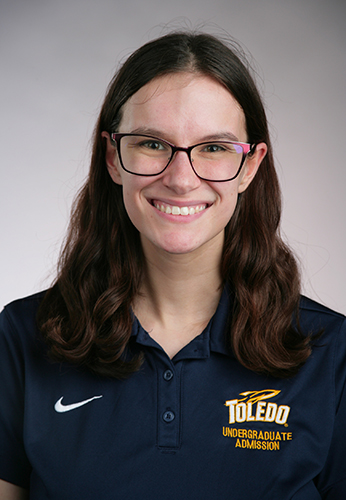For any researcher, the publication of their first peer-reviewed journal article as primary or sole author is a career milestone.
Eryn Close’s experience was little different earlier this year when her work analyzing the body mechanics of young runners appeared in the pages of Gait & Posture. The exercise science major – herself a runner – just happened to reach this coveted milestone sooner than most.

CELEBRATING SUCCESS: UToledo recognizes the Class of 2024 with a series of stories featuring students receiving their degrees at spring commencement.
Receiving top billing alongside the names of her doctoral student collaborator and their faculty mentor, Close served as lead author on the article while still an undergraduate student.
“It is really exciting to have gotten a first-author publication accepted,” she said. “When I initially started out with research, this wasn’t something I was expecting – I didn’t know undergraduate students could be primary authors on research papers.”
Published mere months before she crosses the graduation stage on Saturday, May 4, to earn her bachelor of science degree and Jesup Scott Honors College medallion, the article was a fitting conclusion to Close’s four-year journey as a student scholar at The University of Toledo.
The research presented in the article was conducted at UToledo’s Motion Analysis and Integrative Neurophysiology Lab under the guidance of Dr. David Bazett-Jones, a professor of athletic training in the Department of Exercise and Rehabilitation Sciences. Measuring the joint angles of study participants’ hips, knees and ankles as they ran, the group found that runners yet to experience puberty demonstrate greater variability in the motions of these body parts while running than do post-pubertal runners.
“So, somewhere along those years of growth and development, something causes a change to how much deviation in movement is experienced by adolescent runners,” Close observed.
The measurements were made by 3D motion cameras stationed around the laboratory which track retroreflective dots worn by the study’s participants. As they ran in the space, the cameras detect the shifting light bouncing off the dots amidst the movement and use those datapoints to calculate the changing angles of the runner’s joints throughout the exercise.
Close was introduced to the lab and the work of Bazett-Jones in her first year as a Rocket while exploring opportunities to get involved in campus research. She was paired with a doctoral student as a mentor, Dr. Micah Garcia, who invited her to analyze his kinematic thesis data as a starting point. He then suggested to Close a range of questions she could answer with the dataset, which focused on the biomechanics of young runners, to help her form an investigative focus suitably scoped for a first-year student.
Close, who ran cross-country in high school, settled on the task of comparing motion control shoes with neutral shoes – ones that lack features designed to limit excessive foot motion, such as extra heel or arch padding. The movement of two groups of adolescent runners, each sporting either type of footwear, were scanned in the lab for the study.

Eryn Close, who will receive her bachelor of science degree and Jesup Scott Honors College medallion Saturday, presents her research poster at the Undergraduate Research and Creative Activity Exhibition in December.
When Close’s analysis of the data found similar motion ranges were exhibited between both groups, Garcia suggested she draft an abstract highlighting the results. A few months later, in the summer following her freshman year, Close presented her work at an American Society of Biomechanics conference.
The research would eventually feature in Footwear Science, with Garcia functioning as first author of that publication and Close earning credit as a supporting author.
As her sophomore year rolled around, Close was encouraged by her lab mentors to apply for funding in support of a second project through the Academic Year Research Program hosted by the Office of Undergraduate Research. Though thankfully less involved than the National Institutes of Health grant applications she witnessed her professors pursuing, the AYRP process nonetheless proved an invaluable learning experience for Close.
“After receiving the funding, I spent approximately 150 hours over the following term processing and collecting data in the lab before ultimately creating a poster for the Undergraduate Research and Creative Activity Exhibition in December,” she said. There, Close took first place in the overall competition.
The endorsement was well-placed. It was this work that would eventually form the basis for Close’s first-authored manuscript, an undertaking that spanned her sophomore and junior years.
“Even after writing the article, I was surprised at how long the editing took – responding to the feedback of the reviewers and corresponding with the journal editors,” she recalled. “Despite the time investment, navigating the process offered me precious perspective as to how academic journals actually get published.”
With multiple publications, conference presentations and a successful grant application under her belt, this runner had been put through the paces just in time for her honors thesis. Close was ready to formulate her own research agenda, independently execute it and write-up her findings.

Close served as lead author on published article analyzing the body mechanics of young runners.
With Bazett-Jones as her thesis mentor, Close decided to determine whether an athlete’s biomechanics could be associated with the development of running-related injuries. She tracked those who had participated in the lab’s studies to see if any of them ended up experiencing relevant injuries and then analyzed whether biomechanical variables such as the cadence, peak joint angles and ground reaction forces employed by the eventually-injured participants during their laboratory scans were different from those who remained healthy.
When Close surpasses this weekend’s milestone and receives her degree in exercise science, any victory lap taken will be well deserved. But, like any competitive runner, part of her mind will already begin turning to that next race. Close’s will kick-off in the fall as she starts work on her doctorate in occupational therapy at UToledo.
Dr. John Laux, associate dean of the College of Health and Human Services and its honors director, has proudly watched Close’s growth as a scholar since she started as a Rocket.
“Eryn has been an amazing ambassador for UToledo in general and her department in particular,” he said. “She is an all-star and is greatly deserving of the opportunity to study in the occupational therapy doctoral program. When I think about students who have made the most of their opportunities here, Eryn’s name is among those at the top of my list.”